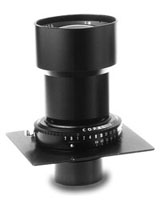Telephoto Lenses For View Cameras
The Long And The Short Of It
I shoot multiple formats ranging from 35mm to 4x5, depending on subject matter and my client's needs, but I love my teles. Whether it's getting up close and personal with a yellow-rumped warbler or attempting to optically isolate some element out of the chaos before me, my telephotos do yeoman duty. Much has been written in Shutterbug, and other photographic publications, regarding telephoto lenses for 35mm. However, telephoto lenses for larger formats, and view cameras in particular, remain a mystery even to many of those who regularly shoot with these cameras. Let's shed some light on these remarkable tools and see if maybe there's a place in your camera bag, not to mention your heart, for one of these big berthas. |
||||
Let's
first clear up a common misconception and see how telephoto lenses actually
work. Many photographers refer to any lens that is longer than normal
as a telephoto lens. In fact, if the lens' physical length, when
focused at infinity, and its focal length are equal it should accurately
be called a long lens. Let's compare two mythical lenses, one a
300mm Wundertar and the other a 300mm Tele-Wundertar. If you focus the
300mm Wundertar on your 4x5 camera at infinity, the distance from the
film plane to the middle of the front element will be approximately 300mm,
or 12". The lens is therefore a long lens.
It is not a telephoto lens even though it is considerably longer than the 150mm normal focal length for a 4x5 camera and should not be referred to as such. However, the Tele-Wundertar focused at infinity, measured in the same way, will be physically much shorter than 300mm due to its telephoto design. Both lenses will have identical angles of view and will include the same amount of the subject in the shot. But the tele lens will require considerably less bellows extension. |
||||
Tele Lens Design |
||||
Telephoto Lenses And Close-Up
Photography |
||||
We all use the Scheimpflug
rule when trying to maximize sharpness with a view camera. You remember,
if the plane of the film, the plane of the subject, and the plane of sharp
focus meet at a common point you have optimum image sharpness. Well, Scheimpflug's
rule still works with telephoto lenses but it's trickier because
the nodal point is hanging out there in front of the lens instead of being
inside the lens where it belongs. Essentially you'll need less tilt
than with normal lenses, and it takes some extra fiddling about to get
it just right. |
||||
It's All In The Chart,
Mostly |
||||
One important characteristic that won't show up in my chart is bulk. View camera telephoto lenses are not petit. Quite the contrary, they're big and much of that bulk needs to fit inside your camera's bellows. Telephoto lenses also tend toward obesity, and that weight hanging off the front of your lightweight field camera may just be the last straw, so to speak. If you want to use a telephoto lens on your 4x5 field camera check first to make sure the front standard has the necessary strength to support it. The extra weight cantilevered off the front of the camera may also mean you'll need to upgrade to a sturdier tripod to eliminate camera shake. No sense spending good money on a sharp telephoto lens and then destroying image sharpness with vibration.
|
- Log in or register to post comments










































